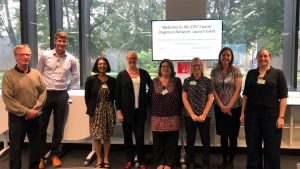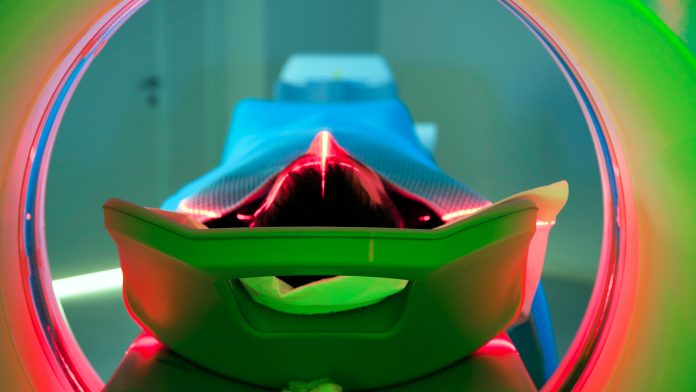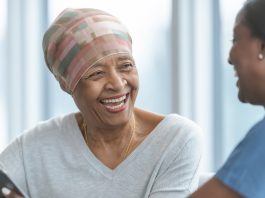In an interview with Innovation News Network, nuclear physicist Laura Harkness-Brennan discusses her work leading the STFC Cancer Diagnosis Network+ and the importance of interdisciplinary collaboration.
Laura Harkness-Brennan’s research at the University of Liverpool traditionally focuses on gamma-ray spectroscopy and imaging. Recently, her expertise in this area has led her to become the principal investigator and lead of the STFC-funded Cancer Diagnosis Network+.
Harkness-Brennan’s work in nuclear physics gives her a unique insight into the world of cancer diagnosis technology. The collaboration of non-medical and medical researchers is the leading driver of the STFC Cancer Diagnosis Network+, and this international and interdisciplinary collaboration could be the missing link in developing new and improved cancer diagnosis technologies.
“We run a network for our members and it’s all about our members. We want people who think they’ve got relevant skills and expertise to come and get involved. Even if that’s just signing up for our newsletter so they can find out about funding opportunities and what the network is doing.
“If others want to offer placement opportunities for researchers to come and work with them for short periods of time, that’s great too. We’re interested in all levels of engagement,” said Harkness-Brennan.

What role does the STFC Cancer Diagnosis Network+ play in the development of new cancer diagnosis techniques?
“Our role is to bring together people from different disciplines to solve cancer diagnosis challenges. This is not just people from academia, it is researchers, either from institutes, universities and even people from a clinical background. Some of those could be clinicians who do not regularly undertake research, and people from industry who are invested in commercialising some of these techniques. We want to develop techniques and technologies that are going to either offer earlier diagnosis for patients or provide more accurate staging of the disease, once it’s been initially identified, to help improve patient treatment plans and secondary care.
“As a nuclear physicist, I don’t have a track record in clinical cancer diagnosis, but I do have skills and expertise developed through my STFC-funded research projects that can be applied to technical diagnosis challenges. The STFC Cancer Diagnosis Network+ aims to bring people like me who undertake research in nuclear physics, particle physics, accelerator science, astronomy and space science together with people who work in hospital settings and other disciplines to see if we can use new ways of solving these kinds of challenges together.
“Within the Cancer Diagnosis Network+, we have four main areas that we are hoping to address: early diagnosis, precision and quantitative imaging, data science in imaging, and multimodal techniques. We are looking at multiple approaches to cancer diagnosis and how you integrate the information to produce a more complete picture. By applying data science techniques to things like imaging or bioinformatics, we’ll be harnessing the kind of computational skills that physicists can offer to solve these kinds of challenges.
“My background as a nuclear physicist is in research and development of radiation detectors. A lot of the cancer imaging technologies, use radiation detectors in their systems, so that’s one example of where the contribution of STFC scientists can help to solve some of these challenges.
“We organise topical workshops to bring people together and facilitate further collaboration between sectors related to cancer diagnosis. Our role is to also to provide funding opportunities to people to allow them to start on what would traditionally be regarded as higher risk research projects. This funding may be for people who do not have a track record in this field, therefore often find it difficult to transition their research to tackle this important challenge. It’s relatively modest funding but the plan is to de-risk those ideas so scientists can apply for larger funding opportunities down the line.”
In addition to funding, does the STFC Cancer Diagnosis Network+ offer any other kind of research opportunities to scientists?
“We aim to embed a modern multi-disciplinary approach in early career researchers so that they can take that forward and influence further mobility between scientific fields. There are good opportunities to do that longer term because of the way that funding councils in the UK have unified under the UKRI umbrella in recent years.
“We are focusing on helping early career researchers through opportunities such as training. For example, we offer training for scientists who would normally undertake their research in astronomy or particle physics, and we can get them on to training courses about bioinformatics which allow them to learn a little bit more about the topic and start to understand how their research skills could be applied to those kinds of topics.
“There are also placement opportunities available through the Network+, which allow researchers to spend some time working with other organisations such as a commercial partner so they can understand a bit more about the commercial drivers behind products and technologies in the healthcare sector.
“We also provide travel opportunities, which are mostly focused on early career researchers, so they can go and attend events related to cancer diagnosis.
“It can take a long time for researchers to translate techniques from their core research activities to address challenges in medicine. In my journey, attending national and international conferences and workshops helped me to network and learn more about the challenges that exist in those in those fields and structures. We provide travel funding for people who wouldn’t ordinarily attend those kinds of events and thus miss out on that all-important engagement. As a lot of early career researchers have very particular travel associated to their research that they’re currently working on, there’s often not a lot funding available for them to go and try different things. We want to give them that mobility so as to enhance their research capacity to get involved in cancer diagnosis research.”
In your experience, how important is interdisciplinary collaboration?
“It is so important. Through putting the Network+ together and talking to people from different backgrounds and fields, I realised that people think differently and it’s not necessarily discipline specific. The way that a physicist approaches a problem could be very different from the way that a biologist or computer scientist approaches the same problem. Bringing new ways of thinking together is very powerful, providing people are ready to listen to each other.
“One of the most difficult challenges is around finding a common level of understanding, so that the whole team can get the best out of each other. One of our main objectives is finding a common working language so that this can be achieved.
“I think collaboration is very powerful. Cancer is a massive global challenge. According to the World Health Organization (WHO), around one in every six deaths globally are due to cancer and it’s the second leading cause of death in the world. We need to address this challenge and provide solutions to tackle it. Additionally, the world’s population is ageing which has serious implications for cancer too. Virtually every country in the world is experiencing growth in the number and proportion of older persons in their population. As people age, cancer incidence rises and the ability of our cells to repair themselves become less effective. So, cancer is going to become even more challenging in the future. Thinking about new ways to solve problems through multidisciplinary collaboration is going to be key.”
What is the greatest challenge that affects the development of cancer diagnosis technology?
“I think lots of people would have different perspectives on that. I believe you need to make a very long-term commitment when being involved in developing technologies that are aimed to be used healthcare setting. So, if you’ve got a really great innovative idea, how do you progress that idea to the preliminary stage? As a researcher, if you have no track record in healthcare, it can be very difficult to build some momentum to demonstrate that you can actually deliver something potentially quite exciting.
“There’s probably a lot of people out there that have really great ideas, but they just don’t have a platform to take them forward. That’s where our Network+ is really trying to help. At that key early stage, we are giving people the platform and an opportunity to engage with other people who have really different levels of expertise.
“Once you’ve got your project up and running, you often start to get some good results. You then talk to some clinicians and they think “oh these look like really nice ideas”. At this point, there is then a ‘valley of death’ that people often talk about when you are trying to scale up a technology from a relatively lab-based product to being applied in a hospital setting. It’s quite a long journey from idea to application, and it’s a huge challenge. There is an increasing awareness and recognition that that pathway is historically difficult, and this is an area that the Network+ is looking to address. Other organisations such as Cancer Research UK have worked really hard on more cancer specific programmes for certain types of cancer, where they bring together different disciplines using much larger pots of money. Generally, these researchers would normally have a more extensive track record in cancer research, so that is where our members would eventually go to for the next step.”
How is the current COVID-19 pandemic affecting the Network+?
“At the onset of the pandemic, I was a bit worried about how we were going to continue to bring people together through the Network+ as the way that we do that is to hold workshops and get people meeting each other face-to-face. Clearly, that is something that’s just not possible at the moment. We were fortunate that we ran a workshop in January, so we aren’t due to run another until later this year. However, we decided to postpone that until 2021 because we still want to leverage the power of face-to-face networking, engagement and ideas generation. We’re hoping to run a remote event later this year to build some momentum leading up to future events and perhaps even make them more effective. We’re having to think about different ways to engage our members which we wouldn’t ordinarily have done before, so it’s driving us to actually enhance the Network+ somewhat.
“We’ve just allocated some funding and are about to award some more for research that is due to start in the autumn. Our researchers across the Network+ will hopefully have access to their labs by that point, so we’ll have our first real research projects up and running at that stage.”
For more information about the STFC Cancer Diagnosis Network+, visit: http://www.stfccancerdiagnosis.org









